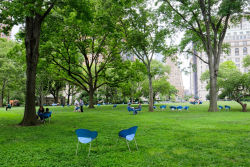The Battery
The Daily Plant : Monday, April 30, 2001
ANOTHER NEW YORK POLITICIAN RECEIVES SPECIAL TREATMENT: ROSCOE CONKLING STATUE IS CONSERVED
On April 18, as part of the renovation of Madison Square Park, work commenced on the conservation of the bronze statue of Roscoe Conkling at the park's southeast corner. The date coincided with the 113th anniversary of the death of Conkling, now forgotten, but once a titan of local and national politics.
Roscoe Conkling served as Mayor of Utica, New York in 1858 and then United States Congressman and Senator from 1859-1881. Conkling's active government role made him the undisputed leader of the Republic Party in New York State and a power broker who controlled federal patronage in the port of New York. He helped draft the 14th amendment to the United States Constitution-giving equal protection under the law to all citizens-and helped form the commission which resolved the electoral outcome of the presidential election of 1876.
In 1881, a dispute with President James Garfield resulted in Conkling's resignation form the senate. On March 12, 1888 Conkling braved the famous blizzard which gripped New York City on that day. Pitched into a snowdrift in Union Square, and struggling for three hours to reach his club at 25th Street, Conkling never recovered from the exposure to the storm, and died six weeks later. Five years, later the Park Board denied a request by Conkling's supporters to place a statue of him in Union Square Park, which, they were told, was reserved for four "Great Americans." By way of compromise, his bronze effigy was installed without ceremony in Madison Square Park on December 1, 1893. John Quincy Adams Ward (1830-1910) who made nine sculptures for New York City's parks, and was one of the most eminent artists of his day, crafted the statue, based in part on having witnessed the charismatic Conkling in action on the senate floor. He depicted Conkling in an active pose, in the midst of delivering a speech.
The $12,000 conservation, which is under the auspices of the City Parks Foundation Monuments Conservation Program, will take several weeks and is being performed by Monuments Conservation Technicians Liz (Statuesque) Short, Martha Seelenberger, and John Cole under the direction of Head Conservator Mark (Lacuna) Rabinowitz. In preparation for the work, the Monuments Program and Art & Antiquities staff researched the history of the statue, and consulted similar works by Ward in the collections of the Metropolitan Museum of Art and New York Historical Society. Now streaked and oxidized, the bronze surface will be washed and cleaned of surface soiling and loose corrosion. It will be chemically repatined to an historically appropriate color and tone. With propane torches, the conservators will warm the surface and apply a coating of lacquer, a matting agent, and wax. Thereafter, the monument will be regularly monitored and maintained.
In the 1940s and 1960s, the monument underwent several treatments. Verbal accounts indicate that the bronzes in Madison Square Park and elsewhere were painted during World War II, possibly to avert their destruction from metal reclamation programs or to reduce reflectivity in the event of an air-raid. In the summer of 2000, as part of the redesign and renovation of Madison Square Park, the nearly eight-foot tall statue on A six-foot high granite pedestal, was relocated 20 feet to what will be a newly landscaped setting
At the height of Conkling's career, his reputation was tarnished due to his confrontation with President Garfield, as well as his reputation as a philanderer. It is hoped that the current conservation will restore the integrity of this fine portrait statue, if not the man.
By Jonathan (Archive) Kuhn, Director of Arts and Antiquities
THIRTEEN YEARS AGO IN THE PLANT
(Monday, May 9, 1988)
PARKS PRINTS 300-YEAR TIMELINE
OF NEW YORK CITY PARK HISTORY
Parks have played an important role in the history of New York, from the days when George Washington strolled along the Battery to the Fourth of July weekend when millions of New Yorkers thronged in Battery Park to view the Statue of Liberty Centennial Celebration in 1986. To help New Yorkers learn more about the fascinating past of our green legacy, Parks has published "Three Hundred Years of Parks: A Timeline of New York City Park History."
"Three Hundred Years of Parks" tells the story of how our parklands grew from Bowling Green-leased by the City for one peppercorn a year to a group of citizens as the first official park in 1773-to the complex 26,178-acre system of today. The 46-page booklet with photos and illustrations is the first complete Parks chronicle ever published by the agency.
QUOTATION FOR THE DAY
"April is a promise that May is bound to keep."
Hal Borland
Check out your park's Vital Signs
Clean & Safe
Green & Resilient
Empowered & Engaged Users
Share your feedback or learn more about how this park is part of a
Vital Park System

Know Before You Go











